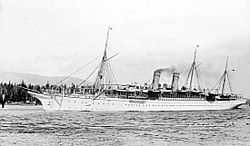RMS Empress of Japan (ship, 1891)
|
||||||||||||||||||||||
|
||||||||||||||||||||||
|
||||||||||||||||||||||
|
||||||||||||||||||||||
The RMS Empress of Japan (I) was an ocean liner of the Canadian Pacific Line put into service in 1891 , which transported passengers, mail and cargo on the Pacific route between Canada and Asia . The ship was decommissioned in 1922 and scrapped in 1926. In over 30 years of service, the Empress of Japan completed 315 Pacific crossings and covered 2.5 million nautical miles (four million kilometers).
The ship

The Empress of Japan and her two sister ships Empress of China and Empress of India , all three of which entered service in 1891, were the first ships of the Canadian Pacific Railway , which had entered the shipping business in 1884. After the company had only used chartered ships up until then, three newbuildings were commissioned in 1890 from the Naval Construction & Armament Company shipyard in Barrow-in-Furness .
The basis was a newly concluded contract between the Canadian Pacific Railway and the British government, which provided for the subsidized transport of mail between Great Britain and Hong Kong via Canada. To this end, three new ocean liners were commissioned in Great Britain to serve this service. These three ships formed the basis for the Canadian Pacific Railway's success in merchant shipping. All three had yacht-like contours and a white hull , which made them look very elegant. They were the first ships in the Pacific to be equipped with twin propellers and piston engines.
The 5905 gross registered tons (GRT) steamship was the last of the three sisters to be launched on December 13, 1890. It was Lady Alice Stanley, Countess of Derby, the daughter of Frederick Arthur Stanley, 16th Earl of Derby in the name Empress of Japan baptized. The ship had a clipper -Bug, two chimneys, three poles and two propellers . On board there was space for 160 passengers in the first, 40 in the second and 700 in the third class. The two triple expansion steam engines developed 10,000 PSi and could accelerate the ship to up to 16 knots. She had a red and green dragon as her figurehead , which is now in the Vancouver Maritime Museum together with the ship's bell . A replica of the figurehead is now in Stanley Park in Vancouver.
Mission history
On April 11, 1891, was Empress of Japan in Liverpool for their maiden voyage to Suez , Hong Kong and Vancouver from. In the following years she served the Vancouver-Japan-Hong Kong route. The Empress of Japan stood out from the fleet of her shipping company because she held the speed record on the Pacific route for two decades. During the First World War , the passenger steamer served as an armed auxiliary cruiser (Armed Merchant Cruiser), as a result of which it lost its stylish white paintwork. An agreement between the Canadian Pacific Railway, the British Parliament and the Canadian government provided that the Empress of Japan should be assigned to the British Admiralty in the event of war .
On June 28, 1914, two days before the Empress of Japan arrived in Yokohama during a routine crossing, war broke out. The steamer was then converted for war use and served as an auxiliary cruiser during the war as intended. In 1916 the ship was returned to its owners. She was the only one of the three sister ships that returned to the Pacific route after the end of the war. The arrival of the Empress of Japan in Vancouver on July 18, 1922 marked her 315th and final crossing. Then the aged ship was launched. In 1923 the ship got a new use when it came from the Canadian Pacific Line to accommodate strikebreakers during a falling out with the Vancouver and District Waterfront Workers' Association. The Empress of Japan was in the port of Vancouver until it was scrapped in North Vancouver in 1926 .
Web links
- Short description in The Ships List (approximately in the middle)

